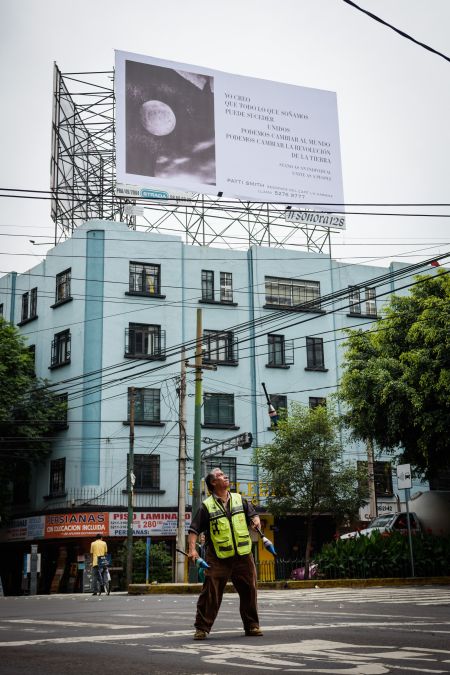Reading M Train (2015) you’d suspect that Patti Smith navigates the world by a precise set of perfect coffee shops. Whilst a Google Earth search would return 24,464[1] Starbucks locations worldwide, Smith would hand over a crumbled notebook page highlighting a dozen or so places, essential points on a globe-spanning pilgrimage:
“Le Rouquet in Paris, Café Josephinum in Vienna, Bluebird Coffeeshop in Amsterdam, Ice Café in Sydney, Café Aquí in Tuscon, Wow Café at Point Loma, Caffe Trieste in North Beach, Caffé del Professore in Naples, Café Uroxen in Uppsala, Lula Cafe in Logan Square, Lion Cafe in Shibuya, and Café Zoo in the Berlin train station.”
Her memoir recounts one pilgrimage, among many, where the writer William S. Burroughs sent a young Smith to the mountains surrounding Veracruz, Mexico, to find the “best coffee in the world”, where she imagined she would write a “post-Beat meditation on [her] substance of choice”. Finding herself in a café of modest appearances, a coffee dealership with chessboard floor and no doors, and no women, several days followed in which Smith drank a coffee, described as “transporting”, an “elixir marrying nature’s extremes,” before she shared a meal with the proprietor, shook hands and left.
Returning to Mexico City some years later it is fitting that Smith is now exhibiting discreetly in one of the city’s most iconic cafés, the Café La Habana, plus extremely publicly on Sonora 128’s billboard gallery. Founded in 1952, La Habana recalls the era of its inauguration: still evident are formica tabletops, ceiling fans, wood panelling and yellow coloured walls. It’s a respectable space yet referencing a radical intellectual spirit. Writers such as Roberto Bolaño and Octavio Paz frequented the café, alongside revolutionaries like Fidel Castro and Che Guevara. It’s grand in scale yet under-occupied, as if time had moved on, which it has.
Entirely without pretension, a series of Smith’s photographs are shown in the windowed entrance of the café, alongside antique cash tills and other remembrances, a gallery and time capsule. There is no sign announcing her name, simply a set of solitary framed shots: a single chair, the bombed shell of the Hiroshima Prefectural Commercial Exhibition building, the genitalia of a Greek statue. Each piece refers to a simple pilgrimage Smith has taken in her life, reflecting an outlook where places are imbued with qualities way beyond their appearances; the simple taking on qualities of the reverential.

Patti Smith performing at Café La Habana, Mexico City on Thursday 31st August 2017 (2017), Image credit: Abigail Enzaldo, Courtesy of the artist and kurimanzutto, Mexico City

Installation shot of Café La Habana Sessions, Café La Habana, Mexico City (2017), Patti Smith, Image credit: PJ Rountree, Courtesy of the artist and kurimanzutto, Mexico City
In a way Smith’s little exhibition collects together tokens of pilgrimages into a site of pilgrimage. The café, with its historic connections, has for a long time been a tourist destination for the tourist who happens to immerse themselves in books of poetry or communist political manifestos. Sit where Che sat. Read where Paz wrote. Drink a simple cup of coffee in a simple space that speaks softly of its history.
Being there is to recognise what is wrong with cafés today. In New York and London the café has become a place of business. It has changed enough over the last forty years that it makes Smith shout at suited men speaking loudly on their cellphones “Don’t you have an office?” In Mexico City queues form outside my local Starbucks (there’s two of them a stone’s throw from each other), hundreds of frappuccinos are served every morning as people go about their business. Even in the trendy coffee joints of the Roma neighbourhood, sans businessman, everyone is doing business on their ubiquitous MacBook Airs, administrating their companies from ‘pop-up’ offices.

Installation shot of Café La Habana Sessions, Sonora 128, Mexico City (2017), Patti Smith, Image credit: PJ Rountree, Courtesy of the artist and kurimanzutto, Mexico City
To this condition Smith’s billboard seems posed to answer the problem. In black and white, an ambiguous photograph (a stone, the moon, the bottom of a coffee cup?) is accompanied by the text: “Yo creo que todo lo que soñamos, puede suceder unidos, podemos cambiar al mundo, podemos cambiar la revilućion de la tierra,” a Spanish translation from her song People Have the Power (1988). For Smith this ‘revolution’ and ‘change’ seems simultaneously to be macro and micro. A call for new generations to tackle extremism in their countries, as well as encouragement to “build another spirit” through small cafés; both actions linked in challenging corporate hegemony.
Below Smith’s famous refrain the billboard continues: “Sesiones del Café La Habana llama +5255 5276 9777,” a hotline to the café to hear a personal session Smith performed, available 24/7. This gesture chimes with Smith’s reaction to the invitation to exhibit in Mexico. At this particular time when divisions between the US and its southern neighbour are so fraught, Smith, as an American, “felt ashamed” to come and speak to a nation with any authority. In lieu of an ability to speak, what remains is the music she has been performing, spreading and speaking via for her entire life.
Elliott Burns
Café La Habana Session call +525552769777.
Elliott Burns is an independent curator, exhibition production-er, writer, ex-artist, sometimes photographer, occasional teacher, approximate art technician, able bartender, decent cook, events co-ordinator, budget organiser, spreadsheet handler, competent admin-er, and happy copy-editor.
Since graduating from MA Culture, Criticism and Curation at Central Saint Martins he has worked with the University of the Arts London as an exhibition curator and teacher. He is the co-founded Off Site Project, an online exhibition space, and lives between Mexico City and London.
Notes
[1] Loxcel Geometics. (2017). How many Starbucks stores are out there?. Retrieved September 6, 2017, from https://www.loxcel.com/sbux-faq.html.
Featured image: Café La Habana (2017), Image credit: Abigail Enzaldo, Courtesy of the artist and kurimanzutto, Mexico City

